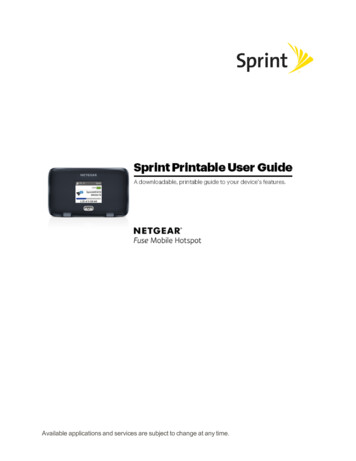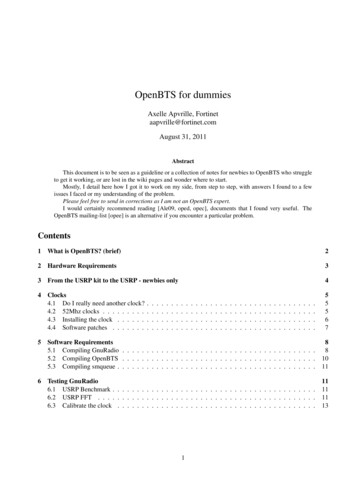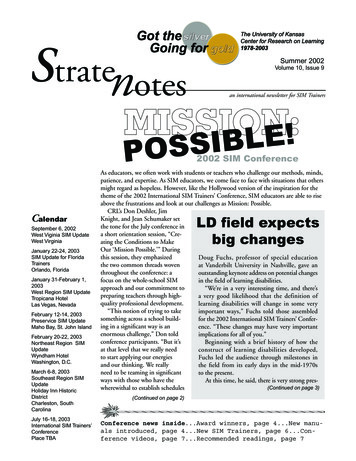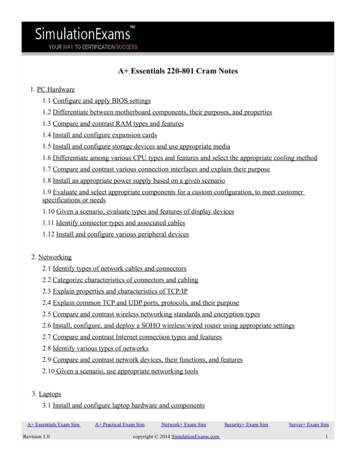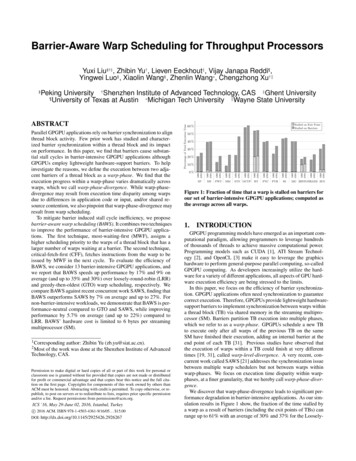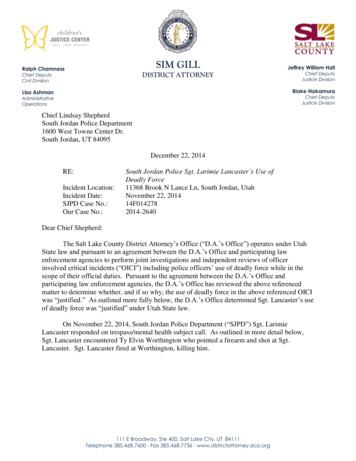
Transcription
SIM GILLRalph ChamnessDISTRICT ATTORNEYChief DeputyCivil DivisionJeffrey William HallChief DeputyJustice DivisionBlake NakamuraLisa AshmanChief DeputyJustice DivisionAdministrativeOperationsCivil DivisionChief Lindsay ShepherdSouth Jordan Police Department1600 West Towne Center Dr.South Jordan, UT 84095December 22, 2014RE:Incident Location:Incident Date:SJPD Case No.:Our Case No.:South Jordan Police Sgt. Larimie Lancaster’s Use ofDeadly Force11368 Brook N Lance Ln, South Jordan, UtahNovember 22, 201414F0142782014-2640Dear Chief Shepherd:The Salt Lake County District Attorney’s Office (“D.A.’s Office”) operates under UtahState law and pursuant to an agreement between the D.A.’s Office and participating lawenforcement agencies to perform joint investigations and independent reviews of officerinvolved critical incidents (“OICI”) including police officers’ use of deadly force while in thescope of their official duties. Pursuant to the agreement between the D.A.’s Office andparticipating law enforcement agencies, the D.A.’s Office has reviewed the above referencedmatter to determine whether, and if so why, the use of deadly force in the above referenced OICIwas “justified.” As outlined more fully below, the D.A.’s Office determined Sgt. Lancaster’s useof deadly force was “justified” under Utah State law.On November 22, 2014, South Jordan Police Department (“SJPD”) Sgt. LarimieLancaster responded on trespass/mental health subject call. As outlined in more detail below,Sgt. Lancaster encountered Ty Elvin Worthington who pointed a firearm and shot at Sgt.Lancaster. Sgt. Lancaster fired at Worthington, killing him.111 E Broadway, Ste 400, Salt Lake City, UT 84111Telephone 385.468.7600 Fax 385.468.7736 www.districtattorney.slco.org
SJPD OICIDecember 22, 2014Page 2UTAH STATE LAWAs part of the review and “justification” determination, the D.A.’s Office relied in partupon the following statutory provisions for the legal analysis:76-2-401. Justification as defense -- When allowed.(1) Conduct which is justified is a defense to prosecution for any offense based on theconduct. The defense of justification may be claimed:(a) when the actor's conduct is in defense of persons or property under thecircumstances described in Sections 76-2-402 through 76-2-406 of this part;(b) when the actor's conduct is reasonable and in fulfillment of his duties as agovernmental officer or employee; 76-2-404. Peace officer's use of deadly force.(1) A peace officer, or any person acting by his command in his aid and assistance, isjustified in using deadly force when:(a) the officer is acting in obedience to and in accordance with the judgment of acompetent court in executing a penalty of death under Subsection 77-18-5.5(3) or (4);(b) effecting an arrest or preventing an escape from custody following an arrest, wherethe officer reasonably believes that deadly force is necessary to prevent the arrest frombeing defeated by escape; and(i) the officer has probable cause to believe that the suspect has committed a felonyoffense involving the infliction or threatened infliction of death or serious bodilyinjury; or(ii) the officer has probable cause to believe the suspect poses a threat of death orserious bodily injury to the officer or to others if apprehension is delayed; or(c) the officer reasonably believes that the use of deadly force is necessary to preventdeath or serious bodily injury to the officer or another person.111 E Broadway, Ste 400, Salt Lake City, UT 84111Telephone 385.468.7600 Fax 385.468.7736 www.districtattorney.slco.org
SJPD OICIDecember 22, 2014Page 3Use of Deadly Force and “Justification as Defense” in UtahReviewing a use of deadly force that results in a person’s death falls within the statutoryobligation imposed on the District Attorney to determine whether a decent died by unlawfulmeans.1 The District Attorney also determines whether acts causing a person’s death warrantprosecution. A District Attorney determination considers whether a person who caused the deathof another nevertheless has a legal defense to prosecution. If a person who caused the death ofanother has a legal defense to ostensible criminal charges related thereto, no charges can bebrought against that person.One legal defense to potential criminal charges available to police officers who useddeadly force and caused the death of a person is the legal defense of “justification.” This legaldefense is found in Utah State Code set forth above and operates in conjunction with other legalauthority.A person’s use of deadly force (including but not limited to use of deadly force by peaceofficers) is “justified” when the use of deadly force conformed to the statutes referenced above.Persons may lawfully defend themselves under circumstances outlined by law, and are affordedthe legal defense of “justification” for the lawful use of deadly force in accordance with statutes.Utah Code Ann. 76-2-402 states that a “person is justified in threatening or using force againstanother when and to the extent that the person reasonably believes that force or a threat of forceis necessary to defend the person or a third person against another person's imminent use ofunlawful force.” Id. This section also states: “A person is justified in using force intended orlikely to cause death or serious bodily injury only if the person reasonably believes that force isnecessary to prevent death or serious bodily injury to the person or a third person as a result ofanother person’s imminent use of unlawful force, or to prevent the commission of a forciblefelony2.” Id.In addition to the use of deadly force in defense of self or others, a peace officer’s use ofdeadly force is “justified” when:“effecting an arrest or preventing an escape from custody following an arrest,where the officer reasonably believes that deadly force is necessary to prevent thearrest from being defeated by escape; and the officer has probable cause to believethat the suspect has committed a felony offense involving the infliction orthreatened infliction of death or serious bodily injury; or the officer has probablecause to believe the suspect poses a threat of death or serious bodily injury to the1U.C.A. 26-4-21. Authority of county attorney or district attorney to subpoena witnesses and compeltestimony--Determination if decedent died by unlawful means. (2) Upon review of all facts and testimony taken concerning the death of a person, the district attorney or countyattorney having criminal jurisdiction shall determine if the decedent died by unlawful means and shall alsodetermine if criminal prosecution shall be instituted.U.C.A. 76-2-402(4)(a): “For purposes of this section, a forcible felony includes aggravated assault, mayhem,aggravated murder, murder, manslaughter, kidnapping, and aggravated kidnapping, rape, forcible sodomy, rape of achild, object rape, object rape of a child, sexual abuse of a child, aggravated sexual abuse of a child, and aggravatedsexual assault as defined in Title 76, Chapter 5, Offenses Against the Person, and arson, robbery, and burglary asdefined in Title 76, Chapter 6, Offenses Against Property.”2111 E Broadway, Ste 400, Salt Lake City, UT 84111Telephone 385.468.7600 Fax 385.468.7736 www.districtattorney.slco.org
SJPD OICIDecember 22, 2014Page 4officer or to others if apprehension is delayed; or the officer reasonably believesthat the use of deadly force is necessary to prevent death or serious bodily injuryto the officer or another person.” U.C.A. 76-2-404.In essence, the analysis for the use of deadly force to prevent death or serious bodily injury(whether by individuals or peace officers) turns on similar elements. Use of deadly force byindividuals: “A person is justified in using force intended or likely to cause death or serious bodilyinjury only if the person reasonably believes that force is necessary to prevent death or seriousbodily injury to the person or a third person as a result of another person's imminent use of unlawfulforce” U.C.A. 76-2-402(1)(a),(b). Use of deadly force by peace officers: “the officer reasonablybelieves that the use of deadly force is necessary to prevent death or serious bodily injury to theofficer or another person,” or to effect an arrest under circumstances set forth in law. See, U.C.A.76-2-404. A peace officer’s use of deadly force is “justified” when that the officer “reasonablybelieves” that the use of deadly force is “necessary to prevent” the threat of “death or serious bodilyinjury.”This OICI investigation and our review that followed was conducted in accordance withan OICI investigation protocol previously established. The OICI investigation protocol strives toestablish an investigation methodology and process that provides the District Attorney with theevidence needed to determine whether a police officer’s use of deadly force conformed to theabove referenced statutes. If the use of deadly force conformed to the statutes, the use of deadlyforce is “justified,” and the legal defense of “justification” is available to the officer such thatcriminal charges cannot be filed against the officer and the criminal investigation into the actionsof the officer is concluded.If the use of deadly force does not conform to the statutes above, the use of deadly forcemay not be “justified,” and the legal defense of “justification” may not be available to the officer.In other words, if the use of deadly force failed to conform to the statutes, the law does not affordthe officer the legal defense of “justification.” Further investigation may be needed to determinewhether, and if so which criminal charges can and should be filed against the officer if any. Justbecause the legal defense of “justification” may not be available (because the use of deadly forcedid not conform to the statutes) does not therefore necessarily mean that criminal charges shouldbe filed against the officer. For instance, the evidence available to the District Attorney may notsupport criminal charges, the case may not have a reasonable likelihood of success at trial, orother reasons may preclude a prosecution. Again, further investigation and consideration may berequired to determine whether the use of deadly force warrants criminal charges.As laid out in more detail below, because we conclude that Sgt. Lancaster’s use of deadlyforce conformed to the relevant statutes outlined above, we therefore conclude that the legaldefense of “justification” applies to the facts set forth herein.111 E Broadway, Ste 400, Salt Lake City, UT 84111Telephone 385.468.7600 Fax 385.468.7736 www.districtattorney.slco.org
SJPD OICIDecember 22, 2014Page 5FACTSThe following facts were developed from the OICI protocol investigation. Shouldadditional or different facts subsequently come to light, the opinions and conclusions containedin this letter may likewise be different.On November 21, 2014, Ty Elvin Worthington’s mother, Edith, called SJPD. She tolddispatchers that Ty was “high on drugs,” and she feared “he might have overdosed,” Edith askedSJPD to “come pick him up.” She said she had driven Ty to a light rail train station and “askedhim not to come back,” but Ty had returned to the home. Edith said Ty was in the bathroomwith the door locked.SJPD and South Jordan Fire arrived at the Worthington home and found Ty not alert; heappeared to have taken heroin and Xanax. Ty was transported to the Lone Peak medical facility.Several hours later, on November 22, 2014, Edith called police again and said that Ty hadcome back to the house and was on drugs. Edith said that Ty had just left the house. Edith toldpolice that Ty took a pistol from the home. Edith told the call taker that the night before, policetold Edith to call them if Ty came back to the house. Edith asked police to come.SJPD dispatched Sgt. Laramie Lancaster to respond to the Worthington home. Oncethere, he spoke with several family members who told Sgt. Lancaster about Ty. Family memberstold Sgt. Lancaster that Ty had recently left the home and taken a .22 caliber pistol with him.Ty’s brother showed Sgt. Lancaster Ty’s bedroom. Sgt. Lancaster saw what appeared tobe bottles of prescription medicine, drug paraphernalia and .22 caliber ammunition in the room.As Sgt. Lancaster left Ty’s bedroom, Edith told Sgt. Lancaster that a neighbor had seen Tywalking towards the house from the north end of Brook-n-Lance Lane. Sgt. Lancaster left theWorthington home to speak with Ty.Sgt. Lancaster’s StatementSgt. Lancaster was interviewed by OICI protocol investigators about the incident.Sgt. Lancaster said he walked northbound away from the Worthington residence to meetTy. Sgt. Lancaster said Ty walked southwest toward a horse corral next to a home at 11368Brook N Lance Ln. Sgt. Lancaster reported on his radio that he could see Ty in the distance.Sgt. Lancaster lost sight of Ty as Ty continued to walk towards the horse corral.Shortly thereafter, Sgt. Lancaster and Ty met each other in the horse corral. Sgt.Lancaster said he asked Ty to come over and talk to him. Sgt. Lancaster told Ty to keep hishands out where he could see them. Sgt. Lancaster said that Ty said “No.” Sgt. Lancaster saidTy didn’t come to him, but instead ran away from him to the northwest corner of the corralwhere a trailer and two boats (on trailers) were parked. Sgt. Lancaster said Ty went behind one111 E Broadway, Ste 400, Salt Lake City, UT 84111Telephone 385.468.7600 Fax 385.468.7736 www.districtattorney.slco.org
SJPD OICIDecember 22, 2014Page 6of the boats. Sgt. Lancaster said he could see Ty’s legs and could see Ty “fishing around” in abackpack.Sgt. Lancaster said that because he believed Ty was armed and may have been usingdrugs, Sgt. Lancaster drew his duty weapon and kept it at low ready. Sgt. Lancaster said hemoved around to try and see Ty.Sgt. Lancaster said as he looked under one of the boats, he could see Ty walking, comingaround from behind the boat. Sgt. Lancaster said he realized he was out in the field of the corralwithout any cover or place to retreat to. Sgt. Lancaster said he again told Ty to come talk to him.Sgt. Lancaster said that as Ty came out from behind the boat, the first thing Sgt.Lancaster saw was a gun in Ty’s hand. Ty was moving towards Sgt. Lancaster. Sgt. Lancastersaid he saw Ty move the gun up and towards Sgt. Lancaster’s direction. Sgt. Lancaster said hefired several rounds at Ty. Sgt. Lancaster said he stopped firing to assess Ty’s situation and heheard the “distinct sound of a .22 going off” and believed Ty fired his weapon.Sgt. Lancaster said he saw Ty recoil and move behind one of the boats and believed Tywas retreating. Sgt. Lancaster called dispatch and reported “shots fired,” and asked forassistance. Sgt. Lancaster said he started to move towards the boat that Ty was behind. Sgt.Lancaster said he was looking under the boat for Ty’s legs. Sgt. Lancaster said as he camearound the boat, he could see Ty with the gun still in his hand. Sgt. Lancaster said he believedhe needed to use deadly force to terminate the threat and he fired again at Ty. Sgt. Lancastersaid he wasn’t going to let Ty fire his weapon at Sgt. Lancaster again.Sgt. Lancaster said he saw Ty’s knees buckle and fell down on the ground. Sgt.Lancaster said Ty still had the revolver in his hand. Sgt. Lancaster said he approached Ty andkicked the gun away from Ty’s hand. At about this time, SJPD Officer Houston arrived at thehorse corral and assisted Sgt. Lancaster in securing Ty in handcuffs. Ty subsequently died fromhis injuries.Physical EvidenceOICI protocol investigators recovered a Ruger .22 caliber single action revolver from thearea next to Ty’s body at the scene. Investigators determined that the weapon was the revolverthe family told Sgt. Lancaster about. Investigators determined and documented that therevolver’s cylinder contained two spent .22 cartridges and four live rounds. Investigators alsorecovered thirteen spent .40 caliber cartridges (consistent with rounds fired from Sgt. Lancaster’sweapon) from the scene.OICI protocol investigators and an armorer inspected the Ruger .22 revolver anddetermined it was a functioning firearm.OICI protocol investigators inspected Sgt. Lancaster’s weapon and found one cartridgestill in the chamber and an empty magazine. Because Sgt. Lancaster said he often keeps his111 E Broadway, Ste 400, Salt Lake City, UT 84111Telephone 385.468.7600 Fax 385.468.7736 www.districtattorney.slco.org
SJPD OICIDecember 22, 2014Page 7fifteen-round magazines one round short of capacity, it is likely that Sgt. Lancaster was thirteenrounds down after the OICI.Sgt. Lancaster was wearing a body camera. SJPD informed OICI protocol investigatorsthat SJPD is in a testing and evaluation phase with body cameras, and therefore has not adoptedpolicies and procedures regarding the operation of body cameras. Nor had SJPD implementedthe use of body cameras at the time. As such, Sgt. Lancaster did not activate the camera prior tothe incident and the camera did not record the shooting.OICI protocol investigators and law enforcement personnel assisting with theinvestigation photographed and diagramed the scene and documented the location of physicalevidence observed at and recovered from the scene.DISCUSSIONSgt. Lancaster Reasonably Believed Deadly Force was Necessary.Sgt. Lancaster responded to a call that involved a trespassed person ostensibly using drugs.Sgt. Lancaster was informed that the person was armed with a pistol. When Sgt. Lancaster wentto look for Ty, it was reasonable for Sgt. Lancaster to consider the probability that the person hewould encounter would be armed and a danger to himself, a danger to others and to Sgt. Lancaster.When Ty produced a weapon and fired, Sgt. Lancaster had to address and react to circumstancesTy created of an imminent, unlawful threat of death and/or serious bodily injury to Sgt. Lancasterand others in the area.Based upon the information provided to Sgt. Lancaster prior to the incident, he reasonablybelieved that Ty had a deadly weapon, and it reasonably appeared to Sgt. Lancaster that Ty was infact using a gun as a deadly weapon. When Ty pointed the gun towards Sgt. Lancaster’s direction,it was reasonable for Sgt. Lancaster to believe that Ty was using unlawful force against Sgt.Lancaster. And when Ty fired the weapon, it was reasonable for Sgt. Lancaster to believe that Tywas using unlawful force. It was also reasonable for Sgt. Lancaster to believe that deadly forcewas necessary to prevent Sgt. Lancaster’s death or serious bodily injury as a result of Ty’simminent use of unlawful force against Sgt. Lancaster. As such, Sgt. Lancaster’s use of deadlyforce was “justified” under Utah State law.111 E Broadway, Ste 400, Salt Lake City, UT 84111Telephone 385.468.7600 Fax 385.468.7736 www.districtattorney.slco.org
SJPD OICIDecember 22, 2014Page 8CONCLUSIONSSgt. Lancaster faced a situation in which he reasonably believed his life was in dangerwhen Ty pointed a gun in his direction and when Ty fired it. Ty’s imminent, unlawful threat ofdeath or serious bodily injury to Sgt. Lancaster made Sgt. Lancaster’s belief that deadly force wasnecessary to prevent his death or serious bodily injury reasonable. Accordingly, Sgt. Lancaster’suse of deadly force was “justified” under Utah State law.If you have any questions or concerns regarding the determination made in this case, orotherwise wish to discuss the matter, please feel free to contact our office to set up a personalmeeting.Very Truly Yours,SIM GILL,Salt Lake County District Attorney111 E Broadway, Ste 400, Salt Lake City, UT 84111Telephone 385.468.7600 Fax 385.468.7736 www.districtattorney.slco.org
DISTRICT ATTORNEY Chief Lindsay Shepherd South Jordan Police Department 1600 West Towne Center Dr. South Jordan, UT 84095 December 22, 2014 RE: South Jordan Police Sgt. Larimie Lancaster's Use of Deadly Force Incident Location: 11368 Brook N Lance Ln, South Jordan, Utah .
